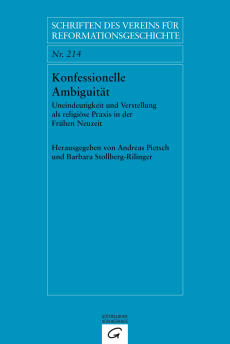Pietsch, Andreas, und Barbara Stollberg-Rilinger (eds.), Konfessionelle Ambiguität. Uneindeutigkeit und Verstellung als religiöse Praxis in der Frühen Neuzeit (Schriften des Vereins für Reformationsgeschichte, vol. 214), Gütersloh: Gütersloher Verlagshaus 2013 (with contributions from Lorenz Baibl, Jürgen Macha, Andreas Pietsch, Matthias Pohlig, Barbara Stollberg-Rilinger, and Karin Westerwelle).
The historians Barbara Stollberg-Rilinger and Andreas Pietsch of the Cluster of Excellence „Religion and Politics“ have edited a new book on ‘Confessional Ambiguity’. The volume, which is published in the series ‘Schriften zur Reformationsgeschichte [Studies on the History of the Reformation]’ examines confessional ambiguity in the early modern period. Scholars of various disciplines use selected examples to analyse the resistance to, fissures in and limits of confessionalisation. The book is based on an interdisciplinary conference held at the Cluster of Excellence, where historians met and discussed with representatives from literary studies, philology, theology, philosophy, art history and Islamic Studies.
The Europe of the early modern period was a laboratory for political and religious pluralism. Up until now scholarship has primarily described the processes of mutual external exclusion and internal homogenisation of the major confessional churches, which accompanied the creation of territorial states. More recently, on the other hand, resistance, fissures and limits in confessionalisation have been emphasised, as well as the permeability that existed among the confessions. In the meantime, the homogenous confessional community has begun to look like a construct. Confession is described as an often wavering and unstable cultural practice.
The volume looks more closely at one part of this cultural practice: ambiguity and dissimulation. Even in contemporary eyes, dissimulation played a large role in both religious and political fields. The cleverness of the courtier required him to conceal his inner self, and Jesuit theological tracts supplied a complex casuistry which allowed dissimulation in certain cases as a necessary evil.
Nevertheless, confessional ambiguity was considered fundamentally somewhat suspicious. The separation of external action and internal conviction posed the very basic question of to what extent confessional dissimulatio was allowed, given internal reservatio mentis. Essentially, it concerned the key question of the relationship between external practice and internal belief, cult and dogma, visible and invisible church, body and soul.
Literature: Andreas Pietsch, Barbara Stollberg-Rilinger (Hg.): Konfessionelle Ambiguität (Schriften des Vereins für Reformationsgeschichte 214), Gütersloher Verlagshaus 2013.


